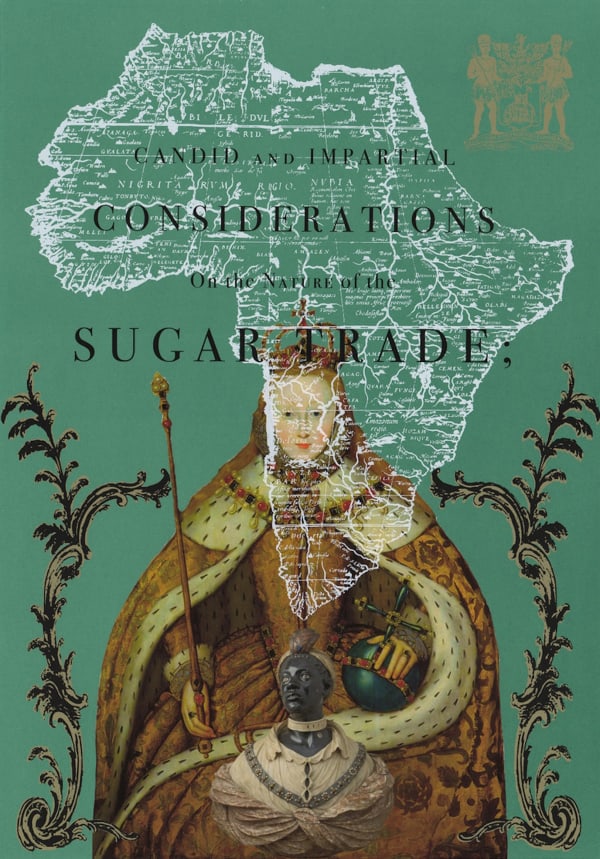-

-
Ground Floor GalleryExhibition: 4th July to 2nd AugustPreview: Thursday 3rd July, 6-8pmA new body of limited edition prints by Billy Gerard Frank in collaboration with Glasgow Print Studio."Rememory as in reassembling the members of the body, the family, the population of the past." - Toni Morrison"The postcolonial space is the site where experimental cultures emerge to articulate new systems of meaning and memory." -Okwui EnwezorColonial Imaginary is a limited-edition print series that excavates the spectral traces of colonialism across shared histories between Scotland, Grenada, and England. Drawing from contested archival fragments, this work reimagines the colonial record-not as static history, but as a living terrain of erasure, resistance, and remembrance. The 'contested' nature of these fragments lies in their political charge (their origins in systems of control and domination) and in the new meanings they take on when placed in dialogue with contemporary diasporic memory, embodiment, and lived experience. Frank's work mines these fragments to question historical narratives, generate counter-histories, and open up spaces for relational meaning and repair.Several images in Colonial Imaginary are drawn from archival records of Paxton House-a stately home in the Scottish Borders, with historical ties to the transatlantic slave trade, and the Waltham Estate in Grenada. Ninian, nephew of Patrick Home, who built Paxton House, was sent to Virginia in 1749 to join his uncle George Home, a former Jacobite exile turned land surveyor and plantation factor. There, Ninian became embedded in networks of landowners and slave traders, and later worked in St. Kitts and Grenada, shipping cargo and enslaved people throughout the Caribbean. After Britain seized Grenada from the French in 1763, he acquired the 400-acre Waltham plantation, followed by a third share in the Paraclete estate. At the peak of his business, Ninian owned around 200 enslaved people at Waltham, and a further 56 at his small share of Alexander Campbell's plantation on Mustique.
-
Embedded within the prints are fragments of paintings, maps, legal texts, and diagrams-now repurposed as a visual framework that carries the visual grammar of empire to interrogate the economic structures underpinning England and Scotland's involvement in the transatlantic slave trade; quantified bodies; territorial lines; ornamental flourishes that once symbolized colonial power and social hierarchies, vis-à-vis systems of control and representation.Colonial Imaginary is anchored in the entangled legacies of empire, slavery, and economic exploitation. It reconfigures visual and textual artifacts drawn from abolitionist debates and plantation records, most notably Thomas Clarkson's infamous slave ship diagram, originally created as empirical evidence of slavery's brutality. Rather than simply reproducing these materials, the series dismantles and reassembles them through a lens of critical play and counter-narrative, challenging the very apparatus of power they once claimed to uphold.The prints also draw from a visual lexicon of imperial power, including Bank of England seals, Queen Elizabeth's royal portraiture, and the Royal African Company seal. The usage of color is both symbolic and referential: drawn from the decorative schemes of Paxton House, with its refined hues of blue and pink inspired by the Chippendale collections (the second largest collection in the UK), and once symbols of British dominance and colonial opulence. Through this aesthetic strategy, the work interrogates how cultural symbols and seals, weighted with traumatic history, can be made to speak anew.These prints do not merely document; they reconstruct. They propose a rememory: a reassembling of displaced lives and fragmented legacies. This work challenges viewers to engage with the afterlives of empire, not as distant history, but as present memory in need of reckoning.
-
Portraits courtesy of Billy Gerard Frank.
From left/top:
Billy Gerard Frank at Glasgow Print Studio
Master Printer Scott Campbell








